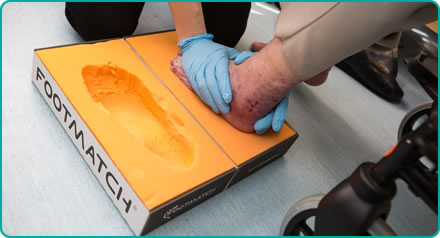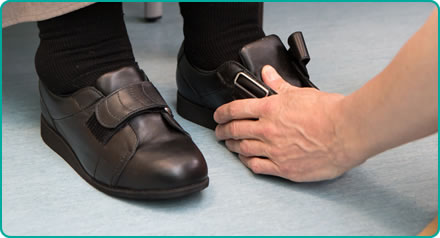You may have been provided with a knee-ankle-foot orthosis, or KAFO, which has been designed to meet your individual needs.
KAFOs are provided to compensate for muscle weakness, paralysis or skeletal problems which cause lower limb instability. The KAFO aims to make standing and walking easier by:
- Controlling joint instability
- Preventing excessive joint motion
- Improving joint alignment
- Reducing joint pain
KAFOs are complex devices so their designs vary to suit each individual.
There are two main types:
1. Metal KAFO with side steels which insert into the heel of your shoe with leather thigh section and calf band.
2. Plastic KAFO with moulded thigh and calf sections which fit inside your shoe, connected by metal side bars.
Using a KAFO puts a large demand on your body and may cause premature wear and tear in your joints.
You should continue to be mindful of your surroundings as the risk of falls remains when using your KAFO.
Wear time
You should gradually increase the wear time with your KAFO. This allows your skin to adjust to the supportive pressures which the KAFO applies. Begin by using your KAFO in a safe, indoor environment.
If your KAFO becomes uncomfortable, discontinue use. If the pain persists then seek advice from the Orthotics department.
Footwear
When selecting shoes to wear with your KAFO, look for the following features:
- Enclosed heel and toe
- Secure lace or velcro fastening
- Removable insole
- Heel height recommended by your orthotist
It is important to select supportive shoes which are comfortable to maximise the benefits of the KAFO.
Skin care
It is advised to wear long socks or tights with your KAFO to reduce any friction applied to your skin.
Each time you remove your KAFO you should check your skin for any signs of marking or redness. If red marks persist for longer than 30mins or if the skin breaks down or blisters, discontinue use of the KAFO and seek a review with your Orthotist.
It is particularly important to check your skin daily if you have reduced sensation.
There is always a risk of pressure and rubbing when wearing a KAFO.
Caring for your KAFO
You can clean your KAFO with a damp cloth and dry with a towel. Do not dry over sources of heat as this may deform the plastic.
Check the KAFO material regularly for any cracks or signs of wear and tear.
Each time you use your KAFO, check the joints and rivets for wear and tear.
Do not attempt repairs yourself, contact the Orthotics department for review.
Straps and padding will wear with use so you can arrange repairs with the Orthotics department.
Putting your KAFO on
You can put your KAFO on when sitting or lying down.
Ensure all straps on your KAFO and footwear are fastened securely.
If your KAFO has knee joint locks, be sure to lock these before bearing weight through the KAFO. You should hear a ‘click’ when you straighten your leg to lock the joints but you should also check these manually.





